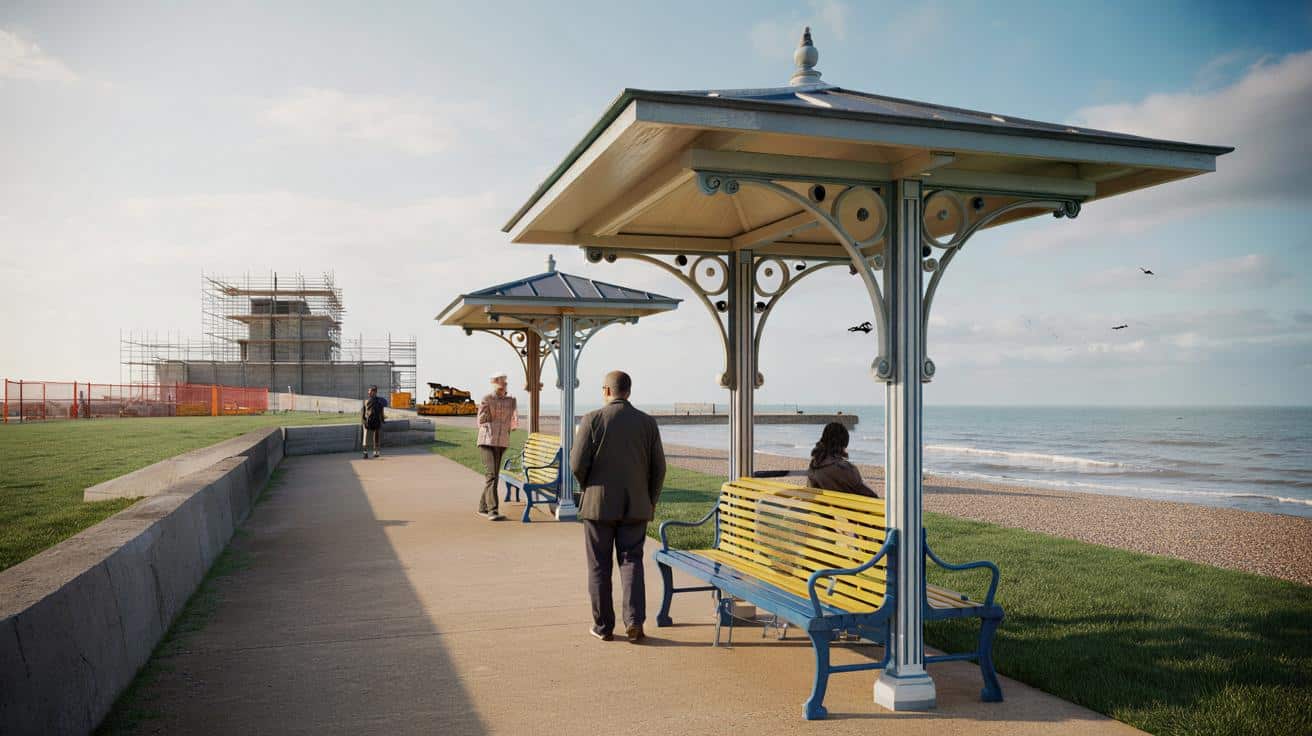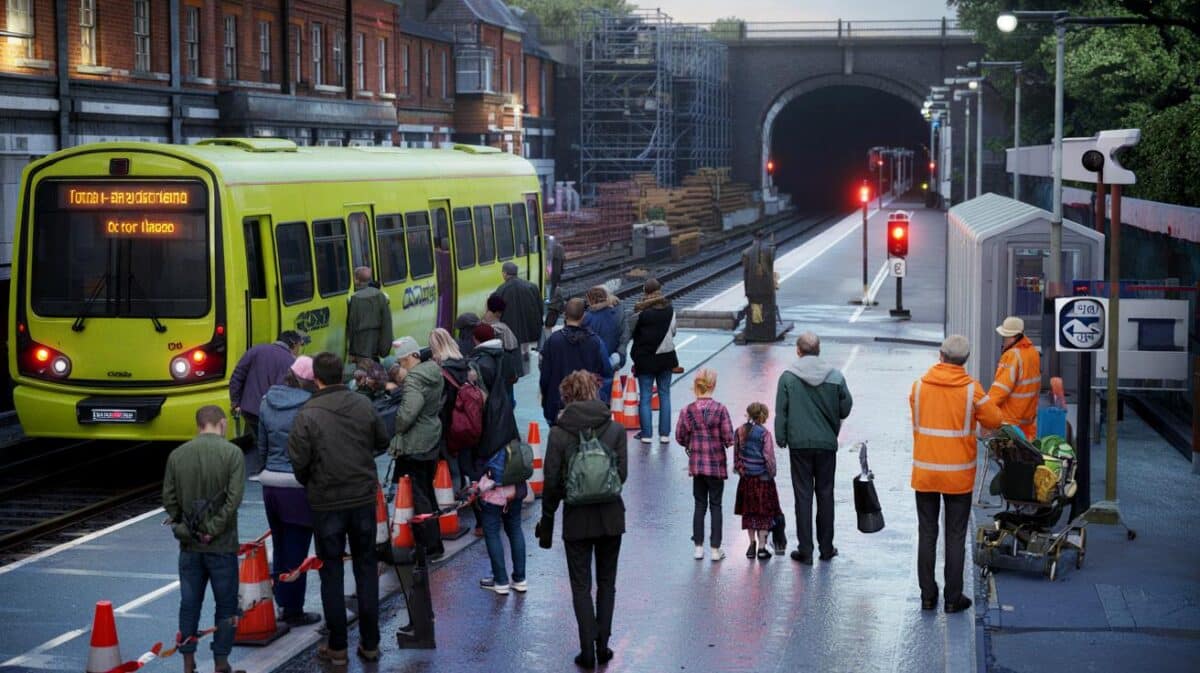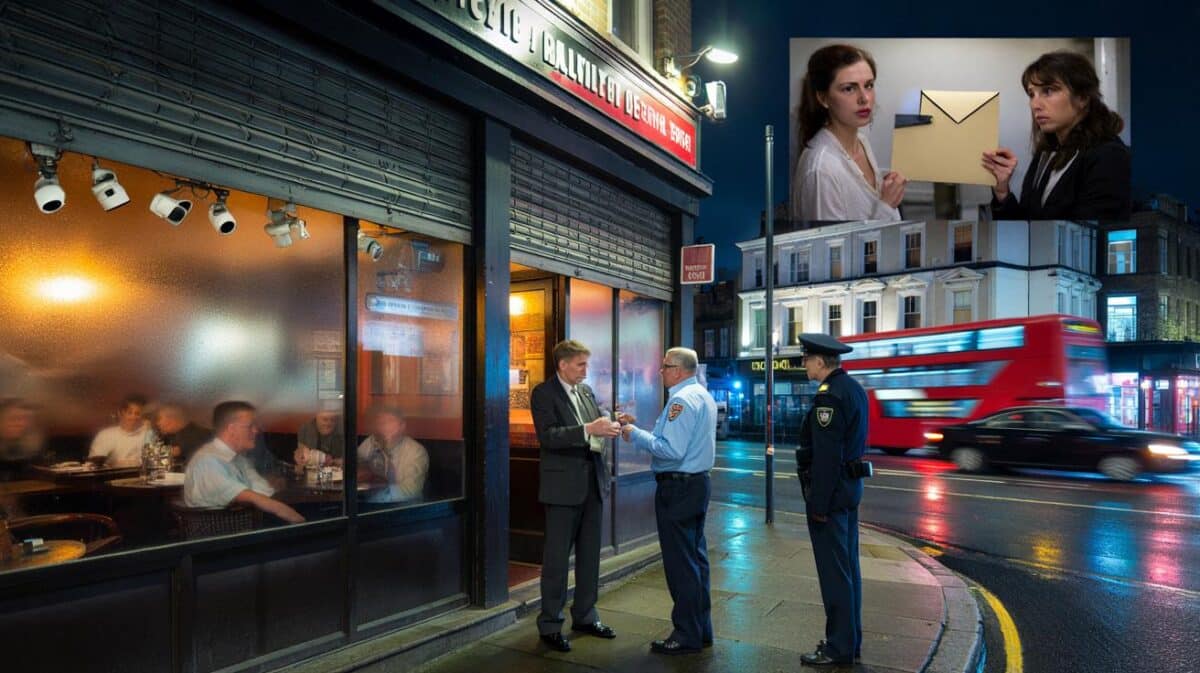Two Grade II-listed seafront shelters have reappeared on the Southsea promenade after careful restoration, marking a vivid milestone in a long-running coastal defence programme that began major works in summer 2023. The yellow-and-blue benches and their elegant canopies now stand close to Southsea Common, with wider promenade access on this stretch expected to reopen by spring 2026.
Two restored, Grade II-listed shelters—removed during 2023 construction—are now back near Southsea Common, bringing colour and cover to a changing shoreline.
Why the shelters matter
These iron-and-timber pavilions date back to the late Victorian and early Edwardian era. They speak to a time when promenading defined seaside life and when public seating was both social infrastructure and civic pride. Their listing reflects architectural charm, craftsmanship and a community bond built over generations.
The shelters offer practical comfort as well as nostalgia. They break a windy walk. They frame viewlines to the Solent. They give families and older residents a place to pause. Their distinct yellow and blue paint reintroduces a cheerful rhythm to a waterfront dominated for now by plant, scaffolding and the hard geometry of new sea walls.
They are more than a photo backdrop; they anchor memory, ease long walks and signal Southsea’s character to visitors and locals alike.
What has changed on the promenade
From dismantling to careful restoration
Engineers and conservators recorded each component before lifting the shelters off the promenade in 2023. Salvageable ironwork was stripped, treated for corrosion and repaired using like-for-like sections. Timber slats were replaced where rot had taken hold, using durable species and hidden fixings to resist salt-laden winds.
Paint removal revealed decades of colour changes. The restored palette now mirrors a familiar Southsea scheme, with bright benches under neat canopies. Behind the heritage detailing, discreet strengthening helps the structures cope with heavier gusts and spray driven by stronger storms.
Where you will find them
The shelters now sit on the seafront near Southsea Common, offering cover within sight of lawns, play areas and open water. Temporary barriers and diversions remain in places while construction continues. Signage directs walkers, runners and cyclists around active works, with phased reopening set to bring back full promenade continuity by spring 2026.
| Year | Milestone |
|---|---|
| Late 19th–early 20th century | Original shelters established on the Southsea waterfront |
| Summer 2023 | Structures dismantled and stored as sea defence construction began |
| 2025 | Two restored shelters reinstalled near Southsea Common |
| Spring 2026 | Promenade section by Southsea Common planned to reopen |
The coastal defence project at a glance
The waterfront works aim to reduce flood risk to homes, businesses and roads along a low-lying frontage. New sea walls, improved drainage and redesigned promenades seek to cope with higher tides and heavier storms while maintaining access to the shore. It is a complex project, executed in stages to keep the seafront usable where possible.
Construction brings noise, diversions and narrowed paths. The return of the shelters provides a visible benefit during the disruption. It signals that the finished promenade will not only be tougher against the sea but also welcoming to people who rely on seating, shade and wayfinding markers.
- Access changes daily as works progress; follow on-site signs for the safest route.
- Expect short pauses near plant and deliveries, especially on weekday mornings.
- Dogs on leads help keep foot and cycle flows smoother on narrowed sections.
- Benches are available again near Southsea Common; please leave space for prams and wheelchairs.
- Check the forecast; spray and crosswinds can pick up quickly on exposed stretches.
What this means for residents and visitors
For walkers, runners and families, the shelters restore a comfortable rhythm to a long shoreline trip. They provide a dry perch in a squall and shade on bright days. They also improve inclusivity by offering regular rest points for those who benefit from breaks—young children, older residents and anyone managing mobility or health conditions.
Local traders near the common gain from dwell time. People linger when they can sit, meet and take in a view. Photo stops and picnic breaks soften the construction backdrop and support nearby kiosks and cafés. Heritage cues also shape the visitor experience, turning a building site into a story of renewal rather than a detour to endure.
How restoration protects heritage by the sea
Salt air attacks metal and timber relentlessly. Conservators use epoxy primers, micaceous iron oxide coatings and careful detailing to keep water away from joints. They choose stainless or galvanised fixings where they will not be visible. They replicate original profiles while adding tiny improvements—drip edges, discreet vents, breathable finishes—that lengthen service life without changing the look.
Regular cleaning prevents salt crusts and grime from trapping moisture. Minor touch-ups after winter storms stop small chips turning into rust blooms. Clear reporting lines help: if a slat loosens or paint flakes, early attention costs less and keeps the shelters safe to use. Residents can flag issues using council channels posted on seafront signs.
Good conservation mixes faithful detailing with quiet upgrades—hidden strength, smarter coatings and maintenance that arrives before damage spreads.
Looking ahead to spring 2026
The promenade by Southsea Common is expected to reopen in spring 2026, restoring full-width access along a high-footfall stretch. Over the coming months, crews will finalise wall sections, set lighting columns and complete surfacing. The reinstated shelters will act as checkpoints as fencing retreats and temporary routes vanish.
Winter testing will matter. Storms will probe joints, paint systems and fixings. Quick remedial work after heavy weather will keep the shelters looking sharp and safe. Visitors can help by using bins, avoiding climbing on the canopies and keeping cycles slow when paths are wet.
Extra context for a richer visit
Grade II listing recognises buildings of special interest. Owners must use sympathetic materials and methods when they repair them. On the seafront, that typically means like-for-like carpentry, paint colours that match historic schemes and metalwork that respects original mouldings. It does not freeze the past; it guides change so that character survives.
Consider a self-guided heritage walk that links the shelters with nearby landmarks: the sweep of Southsea Common, the Rock Gardens, Canoe Lake and the piers. Short stops at frequent benches help families manage distance without strain. If you time a visit around high tide and a gentle breeze, you will see the new walls take the push of waves while people still sit, chat and watch the horizon from those freshly restored seats.









About time—those shelters look brill!
Love seeing the yellow-and-blue shelters back; they break the wind and bring back that Southsea vibe. Kudos to the conservators for the careful restoration and hidden strength. Roll on spring 2026 for a full, smooth promenade.